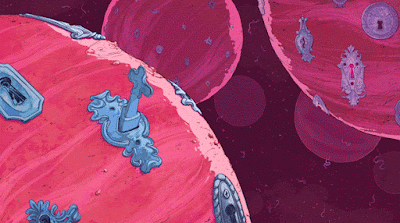 |
| Ricardo Bessa for Quanta Magazine |
Topics: Biology, Biochemistry, Biophysics, Research
Proteins work like rigid keys to activate cellular functions — or so everyone thought. Scientists are discovering a huge number of proteins that shape-shift to do their work, upending a century-old maxim of biology.
Structure equals function: If there’s one thing we all learned about proteins in high school biology, that would be it. According to the textbook story of the cell, a protein’s three-dimensional shape determines what it does — drive chemical reactions, pass signals up and down the cell’s information superhighway, or maybe hang molecular tags onto DNA. For more than a century, biologists have thought that the proteins carrying out these functions are like rigid cogs in the cell’s machinery.
Of course, exceptions would occasionally crop up. A scientist might bump into a protein that performed its functions perfectly well yet didn’t have rigid structures. Most researchers chalked these cases up to experimental error, or dismissed them as insignificant outliers.
More recently, however, biologists have begun paying attention to these shapeshifters. Their findings are tearing down the structure-function dogma.
Proteins are chains of strung-together amino acids, and recent studies estimate that up to half of the total amino acid sequence that makes up proteins in humans doesn’t fold into a distinct shape. (While some of the proteins that make up this total are unstructured from end to end, others contain long unstructured regions side-by-side with structured ones.) “Partly, people didn’t realize how big that number was, and that’s why they ignored it,” said Julie Forman-Kay, a biochemist at the Hospital for Sick Children and the University of Toronto. “And partly they just didn’t know what to think of it.”
This fluidity — dubbed “intrinsic disorder” — endows proteins with a set of superpowers that structured proteins don’t have. Folded proteins tend to bind to their targets firmly, like a key in a lock, at just one or two spots, but their more stretched-out wiggly cousins are like molecular Velcro, attaching lightly at multiple locations and releasing with ease. This quick-on-quick-off binding’s effect in the cell is huge: It allows intrinsically disordered proteins — or IDPs, for short — to receive and respond to a slew of molecular messages simultaneously or in rapid succession, essentially positioning them to serve as cellular messaging hubs, integrating these multiple signals and switching them on and off in response to changes in the cell’s environment and to keep cellular processes ticking along as they should.
Quanta Magazine: The Shape-Shifting Army Inside Your Cells
Alla Katsnelson
Comments